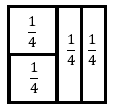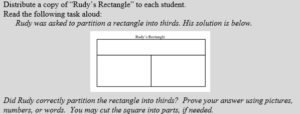Understand a fraction 1/b as the quantity formed by 1 part when a whole is partitioned into b equal parts; understand a fraction a/b as the quantity formed by a parts of size 1/b.
Students are able to…
- Make models of fractions using fraction strips or other manipulatives. They can label each part with the correct unit fraction.
- Explain the meaning of the denominator and the numerator using words, pics, and numbers.
- Understand that, when working with the same whole, the larger the denominator the smaller the size of the pieces because it takes more pieces to make the whole.
- Identify fractional parts of a whole that are the same amount but not the same shape such as in this example:
Students are able to…because teachers:
- Promote the use of manipulatives (could be paper manipulatives) to help students understand the meaning of the numerator and denominator.
- Provide opportunities for the students to share their “definition” of numerator and denominator
- Pose tasks where students compare the size of various unit fractions, helping students develop an understanding that the larger the denominator, the smaller the size of the piece.
Questions to ask students:
- See if students can correctly identify the numerator and the denominator in a written fraction
- Point to a numerator in a fraction (such as 3/4) and ask students what the three represents.
- Sample answer that indicates understanding: The three lets me know that we “are working with” or “we are describing” 3 pieces out of the four pieces it takes to make a whole.
- Sample answer that indicates incomplete understanding or a misconception: The three tells us how many pieces will be shaded.
- Ask students what the numerator in a fraction describes or tells us about:
- Sample answer that indicates understanding: the numerator describes the number of equal pieces it takes to make a whole.
- Draw a square split into four Unequal pieces and ask students if this picture shows fourths
- Sample answer that indicates understanding: No, because the pieces are not equal. With fractions the same unit pieces always have an equal value.
[divider] [/divider] FSA Notes:
Cognitive Complexity Level: 2 – Basic Application of Skills and Concepts
Achievement Level Descriptors:
2- identifies that the numerator is the number of equal parts being considered; identifies that the denominator is the number of equal parts that make up the whole
3- partitions a shape in multiple ways to show understanding that 1/b is equal to one part when the whole is partitioned into b equal parts; shows the fraction a/b as the quantity formed of a parts of 1/b
4- partitions a shape in multiple ways to show understanding that 1/b is equal to one part when the whole is partitioned into b equal parts; shows the fraction greater than 1, a/b, as the quantity formed of a parts of 1/b
5- [intentionally left blank]
Assessment Limits:
Denominators are limited to 2, 3, 4, 6, and 8.
Items are limited to combining or putting together unit fractions rather than formal addition or subtraction of fractions.
Maintain concept of a whole as one entity that can be equally partitioned in various ways when working with unit fractions.
Fractions a/b can be fractions greater than 1.
Items may not use the term “simplify” or “lowest terms” in directives.
Items may not use number lines.
Shapes may include: quadrilateral, equilateral triangle, isosceles triangle, regular hexagon, regular octagon, and circle.
[divider] [/divider] Additional Resources:
Progression of Fractions Across Grade Levels:
Additional in depth content knowledge: (page 50)
Video: Interpreting Fractions as Part of a Whole
[divider] [/divider] Sample Formative Assessment Task:
Resources/Tasks to Support Your Child at Home
- Challenge your child to find all the ways to cut/fold a square into fourths.
- Discuss fair shares when cutting food to be equally shared by your family. Then describe what fractional amount it was cut into including: halves, thirds, fourths, sixths, eighths.
- When eating pizza, discuss the amount eaten by each member of the family. Discuss the importance of the pieces being equal sizes in order to determine the amount each person ate. Then represent the amount with a drawn model.
- Ask your child to share a cake with 6 people equally. Ask: How many parts of the cake will 3 people eat? ( 3/6 of the cake)
- LearnZillion Video : Non-unit Fractions
- Khan Academy: More Than One Equal Section
- LearnZillion Video: Recognize Fractions – Breaking Shapes into Equal Parts
- LearnZillion Video: Write Unit Fractions using Shapes

